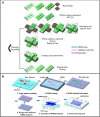3D printing of tissue engineering scaffolds: a focus on vascular regeneration
- PMID: 33425460
- PMCID: PMC7779248
- DOI: 10.1007/s42242-020-00109-0
3D printing of tissue engineering scaffolds: a focus on vascular regeneration
Abstract
Tissue engineering is an emerging means for resolving the problems of tissue repair and organ replacement in regenerative medicine. Insufficient supply of nutrients and oxygen to cells in large-scale tissues has led to the demand to prepare blood vessels. Scaffold-based tissue engineering approaches are effective methods to form new blood vessel tissues. The demand for blood vessels prompts systematic research on fabrication strategies of vascular scaffolds for tissue engineering. Recent advances in 3D printing have facilitated fabrication of vascular scaffolds, contributing to broad prospects for tissue vascularization. This review presents state of the art on modeling methods, print materials and preparation processes for fabrication of vascular scaffolds, and discusses the advantages and application fields of each method. Specially, significance and importance of scaffold-based tissue engineering for vascular regeneration are emphasized. Print materials and preparation processes are discussed in detail. And a focus is placed on preparation processes based on 3D printing technologies and traditional manufacturing technologies including casting, electrospinning, and Lego-like construction. And related studies are exemplified. Transformation of vascular scaffolds to clinical application is discussed. Also, four trends of 3D printing of tissue engineering vascular scaffolds are presented, including machine learning, near-infrared photopolymerization, 4D printing, and combination of self-assembly and 3D printing-based methods.
Keywords: 3D printing; Modeling methods; Print materials; Tissue engineering; Vascular scaffolds.
© Zhejiang University Press 2021.
Conflict of interest statement
Conflict of interestThe authors declare no conflict of interest.
Figures












Similar articles
-
Intelligent Vascularized 3D/4D/5D/6D-Printed Tissue Scaffolds.Nanomicro Lett. 2023 Oct 31;15(1):239. doi: 10.1007/s40820-023-01187-2. Nanomicro Lett. 2023. PMID: 37907770 Free PMC article. Review.
-
Current state of fabrication technologies and materials for bone tissue engineering.Acta Biomater. 2018 Oct 15;80:1-30. doi: 10.1016/j.actbio.2018.09.031. Epub 2018 Sep 22. Acta Biomater. 2018. PMID: 30248515 Review.
-
Three-dimensional (3D) printed scaffold and material selection for bone repair.Acta Biomater. 2019 Jan 15;84:16-33. doi: 10.1016/j.actbio.2018.11.039. Epub 2018 Nov 24. Acta Biomater. 2019. PMID: 30481607 Review.
-
3D Fabrication of Polymeric Scaffolds for Regenerative Therapy.ACS Biomater Sci Eng. 2017 Jul 10;3(7):1175-1194. doi: 10.1021/acsbiomaterials.6b00370. Epub 2017 Jan 5. ACS Biomater Sci Eng. 2017. PMID: 33440508
-
Applications of 3D Bio-Printing in Tissue Engineering and Biomedicine.J Biomed Nanotechnol. 2021 Jun 1;17(6):989-1006. doi: 10.1166/jbn.2021.3078. J Biomed Nanotechnol. 2021. PMID: 34167615 Review.
Cited by
-
Vascularizing the brain in vitro.iScience. 2022 Mar 17;25(4):104110. doi: 10.1016/j.isci.2022.104110. eCollection 2022 Apr 15. iScience. 2022. PMID: 35378862 Free PMC article. Review.
-
Biological Materials for Tissue-Engineered Vascular Grafts: Overview of Recent Advancements.Biomolecules. 2023 Sep 14;13(9):1389. doi: 10.3390/biom13091389. Biomolecules. 2023. PMID: 37759789 Free PMC article. Review.
-
A Review on Bioengineering the Bovine Mammary Gland: The Role of the Extracellular Matrix and Reconstruction Prospects.Bioengineering (Basel). 2025 May 9;12(5):501. doi: 10.3390/bioengineering12050501. Bioengineering (Basel). 2025. PMID: 40428120 Free PMC article. Review.
-
3D bioprinting of in situ vascularized tissue engineered bone for repairing large segmental bone defects.Mater Today Bio. 2022 Aug 8;16:100382. doi: 10.1016/j.mtbio.2022.100382. eCollection 2022 Dec. Mater Today Bio. 2022. PMID: 36033373 Free PMC article.
-
Acellular Tissue-Engineered Vascular Grafts from Polymers: Methods, Achievements, Characterization, and Challenges.Polymers (Basel). 2022 Nov 9;14(22):4825. doi: 10.3390/polym14224825. Polymers (Basel). 2022. PMID: 36432950 Free PMC article. Review.
References
-
- Fang Y, Ouyang L, Zhang T et al (2020) Optimizing bifurcated channels within an anisotropic scaffold for engineering vascularized oriented tissues. Adv Healthc Mater 2000782. 10.1002/adhm.202000782 - PubMed
-
- Nurden AT. Platelets, inflammation and tissue regeneration. Thromb Haemost. 2011;105(Suppl 1):S13–S33. - PubMed
Publication types
LinkOut - more resources
Full Text Sources
Other Literature Sources
